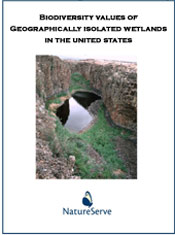 |
 |
|
|
|
|
Biodiversity Values of Geographically Isolated Wetlands in the United States (12.01.05) Executive Summary As a result of a 2001 Supreme Court decision (Solid Waste Agency of Northern Cook County vs. U.S. Army Corps of Engineers, 2001), some wetlands and other waters that are considered "geographically isolated" from navigable waters no longer fall under the jurisdiction of the Clean Water Act. Scientific assessments of the potential impacts of the court's decision are needed to provide guidance to the federal agencies, states, tribes and local governments that will have responsibility for protecting these valuable resources. In this study we sought to assess potential impacts of the court's decision on the nation's biological diversity. To do so, we first used a nationally standardized classification of wetland ecological systems. We then established a working definition to categorize types as "geographically isolated," and using expert knowledge of these wetland types, we narrowed the national list of wetland ecological systems to those that tend to occur "geographically isolated" from navigable waters. Through review of scientific literature, input from regional experts, and compilation of existing location data for at-risk species (those species considered rare, imperiled or critically imperiled using NatureServe's standard criteria) we identified those at-risk species and plant communities that are supported by these isolated wetland types throughout the United States. This assessment used the best currently available information. Because comprehensive wetland maps are unavailable nationally, this study focuses on documenting the number, or diversity, of isolated wetland types, rather than on the acreage these wetland types occupy. These analyses could be significantly augmented in the future with the collection of additional data on the occurrence of isolated wetland types, their spatial extent, and their associated species and communities. Key Findings
Significant wetland diversity exists in every state of the nation. Of 276 types of wetland described for the United States, 81 (29%) met our project-specific definition of "geographically isolated." These types of wetlands may no longer be regulated under the Clean Water Act. Their regulation will therefore largely be determined by how lawmakers, regulators, and the courts interpret the term "isolated." Of the 636 U.S. terrestrial ecological system types (both upland and wetland) currently classified and described by NatureServe (NatureServe 2005), these 81 isolated wetland types amount to 13% of all "natural/near-natural" terrestrial ecological system types. This study documents that isolated wetland ecological systems support high levels of biodiversity, including significant numbers of at-risk species and plant communities. For example:
Wetlands that can be considered "geographically isolated" represent a considerable amount of the United States' ecological diversity and provide habitat for a considerable portion of the nation’s flora and fauna. Significant loss of isolated wetland habitats could seriously affect opportunities for the survival and recovery of the many rare or endangered species that depend on them. Although an unknown but potentially significant number and acreage of these isolated wetlands may lose protection under the Clean Water Act, some may continue to receive protection through other regulatory or voluntary incentive mechanisms. The Endangered Species Act continues to provide a direct regulatory mechanism. Apart from regulation, the U.S. Department of Agriculture’s SwampBuster program is one example of public incentive that may afford some protection to isolated wetlands and the biodiversity they sustain. Underlying any approach to conserve wetlands are the necessary data to adequately locate and identify sensitive resource values. These data are needed to clarify where sensitive resources occur, to allow stakeholders to minimize impacts, and to support mitigating actions. Substantial new investments are needed to systematically inventory wetland resources to more fully document their biodiversity values. This is perhaps the most efficient means to acquire sufficiently high quality and detailed information on wetland biodiversity values and forms the basis for sound resource management. States, tribes and local governments will increasingly be in a position to decide the fate of those isolated wetlands that no longer are protected under the Clean Water Act. The information and analyses contained in this study are designed to assist policy-makers and land managers at federal, state, and local levels to better understand their biodiversity value and plan for their conservation.
Funding for this study was provided by a grant from the U.S. Environmental Protection Agency, Office of Wetlands, Oceans and Watershed — Wetlands Division through a Wetlands Program Development Grant. Report Appendices APPENDICES I-VIII: Download as a single file (PDF, 4M) APPENDIX I: Standards for Ecological Classification (PDF: 603K) APPENDIX II: Dichotomous Keys to Geographically Isolated Wetlands in the United States (PDF: 735K) APPENDIX III: Isolated Wetlands Ecological Systems Descriptions (PDF: 1.9M) APPENDIX IV: At-Risk Animal Species Closely Tied To Isolated Wetland Ecological Systems (PDF: 17K) APPENDIX V: At-Risk Plant Species Closely Tied To Isolated Wetland Ecological Systems (PDF: 51K) APPENDIX VI: Area-Weighted Count of At-Risk Species by County (PDF: 37K) APPENDIX VII: At-Risk U.S.-NVC Associations Closely Tied to Isolated Wetland Ecological Systems (PDF: 58K) APPENDIX VIII: At-Risk U.S.-NVC Associations, Animal Species, and Plant Species Tied to Isolated Wetland Ecological Systems by State (PDF: 269K) APPENDIX IX: State Data Gaps (Excel: 638K) |
Learn More
|
||||||||||||||||||||||||||||||||||||||||||||||||||||||||||||||||||||||||
|
Copyright © 2010 |
|
Support Us
|
|||||||||||||||||||||||||||||||||||||||||||||||||||||||||||||||||||||||||

